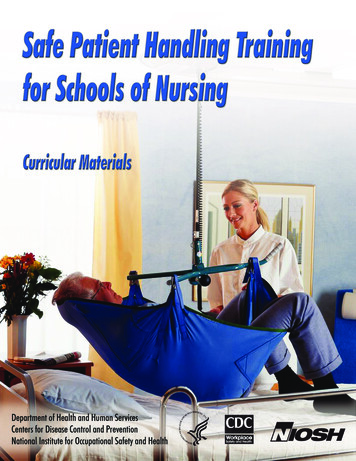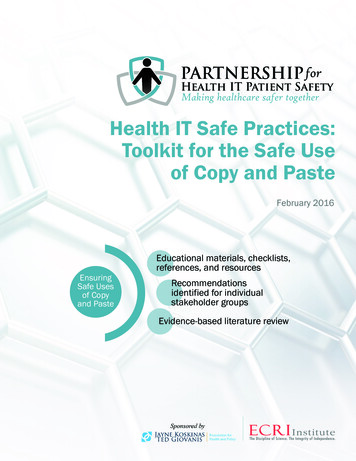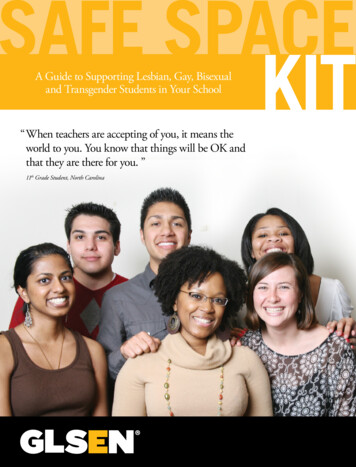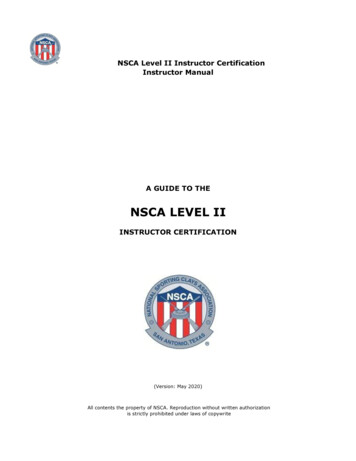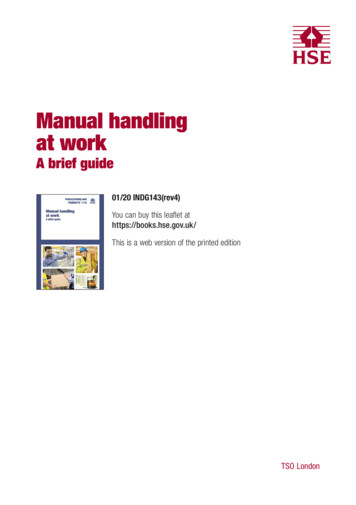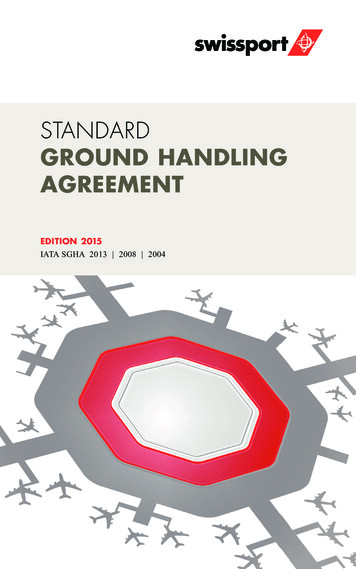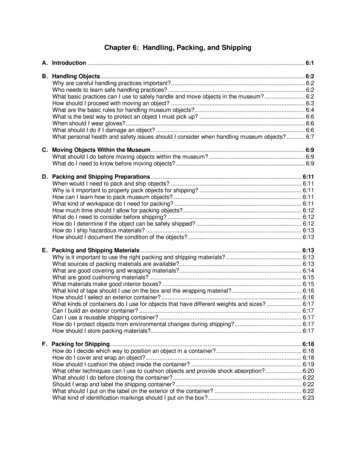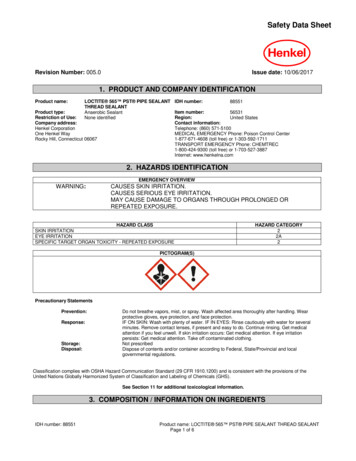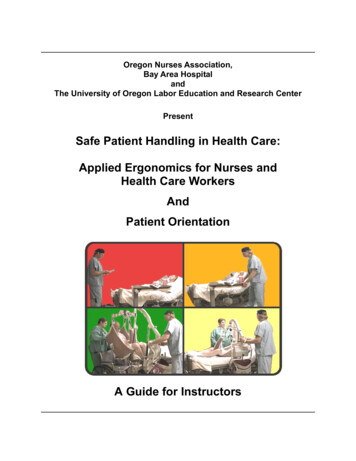
Transcription
Oregon Nurses Association,Bay Area HospitalandThe University of Oregon Labor Education and Research CenterPresentSafe Patient Handling in Health Care:Applied Ergonomics for Nurses andHealth Care WorkersAndPatient OrientationA Guide for Instructors
Safe Patient Handling in Health CareThis material has been made possible by a grant from Oregon Occupational Safety and HealthDivision, Department of Consumer and Business Services.Brand names mentioned or seen in the training materials do not constitute endorsement of thedevice, equipment or product by the Oregon Occupational Safety and Health Division, OregonNurses Association, Bay Area Hospital, the University of Oregon Labor Education andResearch Center or other organizations that support this grant.The information in this booklet is intended to provide general guidance. There may beinstances in which workplace issues are more complex than those presented here. You mayneed the advice of a professional Ergonomist or other experts.The content is intended to provide current information about ergonomics and safety issuesrelated to patient handling and care tasks. The field of ergonomics is dynamic, and newinformation is constantly being developed.Instructional written materials were developed by Lynda Enos, RN, MS, COHN-S, CPE,Nursing Practice Specialist and Ergonomist, Oregon Nurses Association 2004.Supporting partners:Legacy Health SystemsMt. Hood Community College Allied HealthOregon Association of Hospitals and Health SystemsPeaceHealthSamaritan Health ServicesSAIF CorporationPrinted 2004
Safe Patient Handling in Health CareBackgroundNurses, nursing aides, orderlies and attendants suffer more work related musculoskeletal disorders(WRMSDs) that require time off work than any other occupation in the United States (United StatesDepartment of Labor [U.S. DOL], 2000). Back injuries, caused by repeated exposure to forcefulexertions (lifting or pushing) and awkward and prolonged postures associated with lifting andmoving patients manually, are the most common WRMSDs reported by nurses and health careworkers.According to Oregon Workers' Compensation Division data for 2002, over 1,500 health careprofessionals in Oregon received serious injuries on the job that year, 68 percent of those fromsprains, strains and muscle tears.Unfortunately nurses and health care workers are still manually moving and lifting patients using thesame methods that have been taught for over 30 years in the United States, that is, techniques thatare unsafe for both nurses and patients and have been ineffective to reduce the incidence of backinjuries in health care professionals.Ergonomics is about designing work environments and tasks and equipment to fit the physical andcognitive capabilities of workers with the goal of reducing injuries, such as strains and sprains andother WRMSDs, and the risk of mistakes or human errors.This program has been created to assist your organization to reduce WRMSDS associated withmanual patient handling and care tasks. Ergonomics principles that can be used at your facility toidentify and address hazards associated with manual patient handling and other patient care tasks aredemonstrated.Overall Program GoalsThe program is designed to facilitate the use of evidence-based musculoskeletal injury preventionstrategies by nurses and health care workers that: Increase acceptance and use of patient lift and transfer equipment available by nurses andother health care workers, to facilitate safe patient handling and movement. Provide nurses and health care workers with strategies to reduce their risk of WRMSDsthrough participation in the selection of patient handling and other equipment appropriate fortheir work setting and the use of best work practices. Enhance patient perception regarding comfort and security of patient handling equipment,thereby, facilitating patient cooperation to allow use of such equipment.i
Safe Patient Handling in Health CareBackground (continued)About the ProgramThe program is designed with flexibility in mind. Tailor this program to meet your organization’sspecific needs, for example, the materials provided can be used to develop or enhance an existingergonomics or safe-lift program at your facility.This training program is designed to be used as a supplement and in conjunction with the OregonOSHA A Back Injury Prevention Guide for Health Care Providers (provided on the enclosed CDROM) and “Ergonomics Awareness Training” courses available through Oregon OSHA. For moreinformation, go to www.orosha.org or call Oregon OSHA toll-free (888) 292-5247, Option 2.This program is not a substitute for specific training on the safe use of patient handlingequipment. Not all patient handling equipment available is shown in the training videos.The training program is divided into two sections:1. Applied Ergonomics for Nurses and Health Care WorkersMaterials Provided: Instructor guide Video PowerPoint Presentation Participant Handouts Attendance sheet Training quiz Course evaluation2. Patient OrientationMaterials Provided: Instructor guide Video Participant HandoutAll written training documents and other useful reference materials are available on theCD-ROM provided.ii
Safe Patient Handling in Health CareTable of ContentsApplied Ergonomics for Nurses and Health Care Workers Instructor Guide .1Course OverviewIntroduction.2Program Objectives.2Training Materials.3Training Organization .4Scheduling the Training .5Instructor Preparation.6Training Preparation .7After Training Is Completed .8Course Instructional Plan .9Part 1 - Instruction.10Part 2 - Case Studies .33Case Study 1 .35Case Study 2 .37Case Study 3 .39Case Study 4 .41Case Study 5 .43Case Study 6 .45Quiz & Review.47Patient Orientation Instructor Guide .48Course OverviewIntroduction.49Program Objectives.49Training Materials.50Training Organization .50Scheduling the Training .50Training Preparation .51Course Instructional Plan .52Training Presentation .52iii
Safe Patient Handling in Health CareTable of Contents (continued)Appendix: Applied Ergonomics for Nurses and Health Care WorkersAppendix IAppendix IIAppendix IIIAppendix IVAppendix VParticipant Handout: Applied Ergonomics for Nurses and Health CareWorkers Participant GuideAttendance SheetQuizClass EvaluationDefinitions of MSDSAppendix: Patient OrientationAppendix VIAppendix VIIParticipant Handout: A Guide to Equipment used to safely Move, Lift and/orReposition Patients or ResidentsReferences for all MaterialsContents of Safe Patient Handling in Health Care CD-ROM Safe Patient Handling in Health Care: A Guide for Instructors including all appendices. “Applied Ergonomics for Nurses and Health Care Workers” PowerPoint Presentation. A Back Injury Prevention Guide for Health Care Providers. Feletto M., Graze W. (1997).OR-OSHA Consultation Programs. OSHA Guidelines for Nursing Homes: Ergonomics for the Prevention of MusculoskeletalDisorders. (2003). Occupational Safety and Health Administration. Ergonomics Program Steps for Health Care Flow Chart. Enos, L. (2003). Patient Safety Center of Inquiry, Veterans Health Administration, and Department ofDefense Veterans Administration Hospital, Tampa, Florida, resource documents: -Patient Care Ergonomics Resource Guide: “Safe Patient Handling and Movement.2001, Part 1 & 2”-Algorithms for Patient Handling-Algorithms for BariatricsResource list for further information.iv
Safe Patient Handling in Health CareApplied Ergonomics for Nurses and Health Care WorkersSafe Patient Handling in Health Care:Applied Ergonomics for Nurses andHealth Care WorkersInstructor Guide1
Safe Patient Handling in Health Care:Applied Ergonomics for Nurses and Health Care WorkersCourse OverviewIntroductionThe Safe Patient Handling Program: Applied Ergonomics forNurses and Health Care Workers is a training program designedto help health care facilities and nursing educators teach nursesand other health care workers how to reduce their risk of back andother work related musculoskeletal disorders (WRMSDs).Participants will learn to identify and implement strategies toeliminate or reduce hazards associated with patient handling andmovement and other patient care tasks, using engineering, workpractice and administrative controls.It is recommended that this training session be conducted byoccupational health and safety personnel, ergonomists, educatorsor health care providers who are knowledgeable in the principlesof ergonomics and safe patient handling.Use the A Back Injury Prevention Guide for Health CareProviders, the OSHA Guidelines for Nursing Homes: Ergonomicsfor the Prevention of Musculoskeletal Disorders and otherreference documents provided in the enclosed CD-ROM foradditional guidance as needed when planning your trainingprogram.Program ObjectivesThe content of the training teaches employees to: Identify why there is no Safe Way to perform manualpatient handling tasks. Identify risk factors that contribute to WRMSDsassociated with manual patient handling tasks. Define strategies to eliminate or reduce hazards forWRMSDs, using engineering, work practice andadministrative controls.2
Safe Patient Handling in Health CareApplied Ergonomics for Nurses and Health Care WorkersCourse OverviewTraining MaterialsThe Safe Patient Handling Program: Applied Ergonomics forNurses and Health Care Workers includes the followingmaterials:1. Video“Applied Ergonomics for Nurses and Health Care Workers”Section 1 – Instruction. Allow 12 minutes to view thissection of the video.Section 2 – Practice Activity: Six Case Studies. Allow 18minutes to view all case studies plus additional time fordiscussion and/or group work.2. PowerPoint slides on CD-ROM that provides optionalsupporting materials for Sections 1 and 2 of the video.3. Facilitator guide that includes: A course overview (which you are reading now) Instructional plan An appendix that includes:- Participant handout (which includes a PracticeActivity worksheet)- Attendance sheet- Quiz- Class evaluation- Definitions of MSDsThe materials listed above are also available on theenclosed CD-ROM.Additional required materials: VCR Computer projector and laptop computer with PowerPointsoftware or an overhead projector and printed PowerPointoverheads Projector screen Flip chart and pens3
Safe Patient Handling in Health CareApplied Ergonomics for Nurses and Health Care WorkersCourse OverviewTraining OrganizationThe Safe Patient Handling Program: Applied Ergonomics forNurses and Health Care Workers is designed with built-inflexibility for you to adjust training timeframes to meet yourspecific needs.This training employs the following activities and instructionaltools: Section 1 of the instructional video Applied Ergonomics forNurses and Health Care Workers reviews common causes ofWRMSDs, such as back injuries associated with patienthandling and care tasks, and identifies ergonomics principlesused to eliminate or reduce the employee’s risk of injury. Asystematic 4-step process that employees can use to helpreduce their risk of injury is presented. Optional review and further exploration of WRMSDprevention strategies for nurses and health care workers, usingthe PowerPoint presentation. In Section 2 of the instructional video Applied Ergonomics forNurses and Health Care Workers, case studies providestructured activities that allow participants to practiceidentifying risk factors for WRMSDs and use the 4-stepprocess to define engineering and work practice solutions. Multiple choice quiz.4
Safe Patient Handling in Health CareApplied Ergonomics for Nurses and Health Care WorkersCourse OverviewScheduling the TrainingWhen scheduling the training session, groups of no more than 20employees are recommended. This promotes interaction betweenthe trainer and participants and facilitation of the structuredactivities.You might want to identify an employee(s) who would like toshare their experience with the group of an injury related topatient handling and the impact of the injury on their life.A testimonial from a respected co-worker can be extremelyeffective in convincing staff to improve their injury preventionbehaviors, such as using lift equipment and best work practices.Section 2 of the video provides six case studies or scenarios thatto allow participants to identify risk factors and hazards thatcontribute to WRMSDs and to determine a safer way to performeach patient handling and care task. Each study demonstrates anunsafe method of performing a patient handling task and thenshows the same task performed in a safer manner using goodwork practices and appropriate patient handling equipment.Case Studies Provided:Case Study 1:Repositioning Patient in BedCase Study 2:Transfer from Chair to BedCase Study 3:Transfer from Bed to StretcherCase Study 4:Transfer from Wheel Chair to BedCase Study 5:Making a Bed and RepositioningPatient in BedCase Study 6:Patient Ambulation and Fall RecoveryIf this material is used as is, this session could last one to one andone-half hours. Choose from the supplied materials what isappropriate for your participants. Incorporate items specific toyour organization and/or additional material related to certaintopics, such as access to and safe use of patient handlingequipment and best work practices.5
Safe Patient Handling in Health CareApplied Ergonomics for Nurses and Health Care WorkersCourse OverviewInstructor PreparationLearning Objectives:Upon completion of the Safe Patient Handling Program: AppliedErgonomics for Nurses and Health Care Workers programparticipants will be able to: Identify activities at work or away from work that could putyou at risk of musculoskeletal disorders (MSDs). Identify the primary risk factors that can contribute to thedevelopment of work related MSDs. Define why manual patient handling tasks are unsafe. Define health care ergonomics. Define engineering, work practice and administrativecontrols. Identify examples of work practice controls that can helpreduce your risk of injury when performing patient handlingand care tasks. Describe the four action steps that can reduce your risk ofinjury.Behavioral Objectives:Upon completion of the Safe Patient Handling Program: AppliedErgonomics for Nurses and Health Care Workers programparticipants will be able to demonstrate the following behaviors:Use the following four step process when performing patienthandling and transfer and other care tasks:1. Assess the patient to determine appropriate method of liftor transfer.2. Assess the environment and remove hazards.3. Get necessary equipment and help as required.4. Perform the task safely.6
Safe Patient Handling in Health CareApplied Ergonomics for Nurses and Health Care WorkersCourse OverviewTraining Preparation1. Identify the location of the room in which you will conductthe training. Ideally, the room will be quiet, well ventilated,and well lighted. Classroom style seating will allowparticipants to take notes and form discussion groups ifdesired.2. Schedule the session and send out notices to managers andsupervisors. Prepare employees for training by distributingflyers and posters and/or using e-mail distribution and Intranetpostings.Before you conduct the training session:3. Review all program materials thoroughly. Customize theprogram to meet your training goals and to includeinformation pertinent to your organization. Consider usingpictures or videos from your facility whenever appropriate.4. Make notes of example discussion questions and anticipatequestions participants are likely to ask.5. Determine how to best facilitate case studies activities in Part2 of the video.6. Practice presenting the program.7. Make enough copies of the Participant Handout (including thePractice Activity worksheet) as necessary and the session quizfor all those attending the session.8. Copy the quiz to your PowerPoint presentation or make anoverhead transparency to facilitate discussion of answers withthe group.9. Copy the attendance and evaluation sheets.10. Gather and prepare other materials specific to yourorganization that you need for the training and practice, suchas your facility’s safe lift policy and procedure, and patienthandling equipment instructional materials.7
Safe Patient Handling in Health CareApplied Ergonomics for Nurses and Health Care WorkersCourse OverviewTraining Preparation(continued)11. Prepare flip chart pages and/or use PowerPoint slides: Agenda Objectives An outline of your organization’s ergonomics and/orsafe patient handling and movement program Other pertinent information and/or discussion points12. Test computer and TV/VCR equipment.13. Cue up the video so it is at the starting point.14. Remember, wherever possible, it is important to allow theparticipants to actively participate in the session. This allowsparticipants to take an active role in learning, and increasesthe ability to recall what is learned.After Training IsCompletedMake sure that all participants sign the attendance sheet andcomplete a course evaluation form. Collect: Applied Ergonomicsfor Nurses and Health Care Workers quiz and course evaluationforms.Keep all written training materials, attendance sheets and quizzesper your facility’s training policies.8
Safe Patient Handling in Health CareApplied Ergonomics for Nurses and Health Care WorkersCourse Instructional PlanPlease read the following before planning your training program.The Course Instructional Plan can be adapted to fit your training goals and time frame.Section 1 – InstructionSlides 1 - 4 are required. Use the slides provided or transfer content to a flip chart.Slides 5 - 32 are recommended but not required. These slides provide review and furtherinformation about ergonomics, risk factors for MSDs and principles for MSD prevention. Youmay use all or some of these slides as a basis for further instruction about specific topics or itemsyou wish to discuss.Slides 33 - 42 are recommended but not required. These slides may be used to review and discussthe 4-Step process that employees can use to help reduce their risk of injury together withelements of your facility’s safe lift policy, such as selecting the safest equipment and handlingtechnique based on patient characteristics.Section 2 – Practice Activity: Case StudiesSlides 43 - 80 are required. These slides provide information for each of the six case studies thatshould be used to facilitate discussion and application of the 4-Step injury prevention process.You may choose to use all or some of the case studies for the practice activity.Slides 45 - 49Case Study 1: Repositioning Patient in BedSlides 50 - 54Case Study 2: Transfer from Chair to BedSlides 55 - 61Case Study 3: Transfer from Bed to StretcherSlides 62 - 68Case Study 4: Transfer from Wheel Chair to BedSlides 69 - 73Case Study 5: Making a Bed & Repositioning Patient in BedSlides 74 - 80Case Study 6: Patient Ambulation and Fall Recovery9
Safe Patient Handling in Health Care:Applied Ergonomics for Nurses and Health Care WorkersCourse Instructional PlanMaterials to UseTeaching GuideSlides 1 - 4 are required. Use the slides provided or transfer content to a flip chart.Welcome employees to the session and introduceyourself.IntroductionsDiscuss locations for restrooms, beverages, etc. Youmay want to ask if this could be a “cell-free zone.”Recommend pagers be set to vibrate.Slide 11Safe Patient Handling Program:Applied Ergonomics for Nursesand Health Care WorkersIntroduce the workshop Safe Patient HandlingProgram: Applied Ergonomics for Nurses and HealthCare Workers. Discuss how the workshop fits into yourorganization’s or facility’s ergonomics and safe patienthandling program.Remind employees of the importance of:This material has been possible by a grant from Oregon Occupational Safety andHealth Division, Department of Consumer and Business Services. Safety in your organization. Their role in your organization’s orfacility’s ergonomics and safe patienthandling program.Optional Activity:Ask volunteer participant(s) who were identified beforethe class to share their experiences related to patienthandling.10
Safe Patient Handling in Health CareApplied Ergonomics for Nurses and Health Care WorkersCourse Instructional PlanMaterials to UseTeaching GuideSlide 2Refer to the training objectives. Identify activities at work or away from work thatcould put you at risk of musculoskeletal disorders(MSDs).Review TrainingObjectives2Session Objectives Identify activities at work or away from work that could putyou at risk of Musculoskeletal Disorders (MSDs). Identify the primary risk factors that can contribute to thedevelopment of work related MSDs. Define why manual patient handling tasks are unsafe. Identify the primary risk factors that can contributeto the development of MSDs. Define why manual patient handling tasks areunsafe. Define health care ergonomics. Define engineering, work practice andadministrative controls. Identify examples of work practice controls thatcan help reduce your risk of injury whenperforming patient handling and care tasks. Describe the four action steps that can reduce yourrisk of injury. Define health care ergonomics. Define engineering, work practice and administrativecontrols. Identify examples of work practice controls that can helpreduce your risk of injury when performing patient handlingand care tasks. Describe the four action steps that can reduce your risk ofinjury.Slide 3Review Agenda3Session AgendaReview the agenda (the slide provided or a flip chartcould be used). Background. Background The ABC Hospital Safe Patient Handling Program Applied Ergonomics for Nurses and Health CareWorkers Video: Section 1 The ABC Hospital Safe Patient Handling Program(Your facility’s program). Applied Ergonomics for Nurses and Health CareWorkers Video: Section 1. Review key points from video. Applied Ergonomics for Nurses and Health CareWorkers Video: Section 2 – case studies. Case Studies: Discussion and group work. Quiz and evaluations Review Key Points from Video Applied Ergonomics for Nurses and Health CareWorkers Video: Section 2 – Case Studies Case Studies: Discussion and Group Work Quiz and Evaluations11
Safe Patient Handling in Health CareApplied Ergonomics for Nurses and Health Care WorkersCourse Instructional PlanMaterials to UseSlide 4Teaching GuideShow Video (12 minutes) Present the “Safe Patient Handling Program: AppliedErgonomics for Nurses and Health Care Workers”Video.2 Brand names mentioned or seen in the training videodo not constitute endorsement of the device,equipment or product by the Oregon OccupationalSafety and Health Division, Oregon NursesAssociation, Bay Area Hospital,the University of Oregon's Labor Education andResearch Center or other organizations who supportthis grant.You may show Slide 4 before the video. Equipment shown in this video may vary from theequipment used by your health care facility. Not allpatient handling equipment available is shown in thevideo.Stop the video at “Case Studies” if you plan to reviewthe information given in the first part of the videoand/or divide participants into groups for the practiceactivity. This training session is not a substitute for specifictraining on safe use of patient handling equipment. Always follow the patient handling policy at yourfacility.Encourage participants to watch for: The causes of musculoskeletal disorders (MSDs). Methods of reducing their risk of injury (MSDs)when performing patient care and handling tasks.Slides 5 - 32 are recommended but not required. These slides provide review andfurther information about ergonomics, risk factors for MSDs and principles forMSD prevention. You may use all or some of these slides as a basis for furtherinstruction about specific topics or items you wish to discuss.Slide 5Background5BackgroundShow Slide 5 and inform participants that you will nowreview and discuss the injury prevention concepts andideas presented in the video.Safe Patient Handling Program:Applied Ergonomics for Nurses andHealth Care Workers12
Safe Patient Handling in Health CareApplied Ergonomics for Nurses and Health Care WorkersCourse Instructional PlanMaterials to UseTeaching GuideSlide 6Show and review Slide 6The Incidence of MSDsin Health Care The most common MSDs reported by nurses andnursing aides are strains or sprains and injuries dueto overexertion (lifting, pushing or pulling)associated with patient handling tasks. At risk Occupations for Strains and Sprains, 20006The Incidence of MSDs in Health Care The most common MSDs reported by nurses andnursing aides are strains or sprains and injuriesdue to overexertion (lifting, pushing or pulling)associated with patient handling tasks. At risk Occupations for Strains and Sprains, 2000# 1 Truck Drivers# 2 Nursing aides, orderlies & attendants# 3 Laborers# 6 RN’s# 18 LPNs# 1 Truck Drivers# 2 Nursing aides, orderlies & attendants# 3 Laborers# 6 RNs# 18 LPNs(Source: U.S. DOL, 2002)Source: U.S. DOL, 2002Additional information that you may choose topresent:Studies show that nurses leave the profession due toback pain.The risk of MSDs associated with manual patienthandling may lead to increased absenteeism, jobturnover and decreased staff retention.Why is manual patient handling so hazardous?SlidesWhy is Manual Patient7, 8 & 9 Handling So Hazardous?Ask participants to give examples of work factors thatmake manual patient handling hazardous.Why is Manual Patient7Handling So Hazardous? The Physical Demands of Work– Patient Weight (heavy load) Shape (bulky and awkward) Behavior (unpredictable, confused, fragile,in pain)– High repetition of tasks Equipment and Facilities Design– Constricted work space– Poorly maintained equipmentShow Slides 7, 8, & 9Emphasize that the physical effort required torepeatedly lift and move patients manually is greaterthan your musculoskeletal system can tolerate.The physical demands of work Patient- Weight (heavy load)- Shape (bulky and awkward)- Behavior (unpredictable, confused, fragile, inpain)- High repetition of tasks13
Safe Patient Handling in Health CareApplied Ergonomics for Nurses and Health Care WorkersCourse Instructional PlanMaterials to UseSlides7, 8 & 9Cont.Teaching Guide8Why is Manual PatientHandling So Hazardous? Equipment and Facilities Design, e.g.,- Constricted work space- Poorly maintained equipment Poor Work Practices, e.g.,- Adjustments on equipment (e.g., bed) not used Personal Factors:- Off the job activities, e.g., Lifting and handlingchildren, trash, shopping or performing yardwork, etc.- Previous injury Poor Work Practices– Adjustments on equipment (e.g., bed) not used Personal Factors– Off the job activities e.g., Lifting and handlingchildren; trash; shopping, or performing yardwork, etc– Previous InjuryRemember: Using good bodymechanics is notenough to prevent back injuries and other MSDscaused by manual patient handling.9Why is Manual PatientHandli
Each study demonstrates an unsafe method of performing a patient handling task and then shows the same task performed in a safer manner using good work practices and appropriate patient handling equipment. Case Studies Provided: Case Study 1: Repositioning Patient in Bed Case Study 2: Transfer from Chair to Bed
